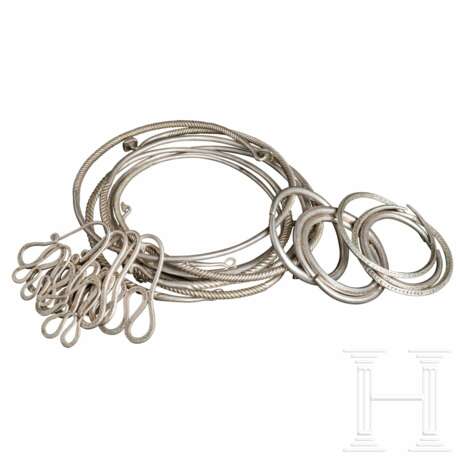ID 946749
Lot 53 | 18-teiliger Hortfund von Silberschmuck, wikingerzeitlich, 10. - 11. Jhdt.
Estimate value
€ 20 000
Darunter fünf große Halsreife mit sich überlappenden Enden.
1) Ein Stück mit abgewinkelten, kugeligen Enden, diese mit Filigran und Granalien verziert, in der Mitte eine Glaseinlage in Fassung. Das hintere Ende rundstabig und glatt, vorne im Querschnitt flach sechskantig facettiert und auf der Oberseite mit Kreispunzen verziert. Durchmesser ca. 22 cm.
2) Zwei gleichartige Stücke mit rundstabigem Hinterteil und tordiertem Vorderteil, die Enden zurückgebogen und mit facettierten, viereckigen Knöpfen versehen. Ein Stück mit Kreispunzen am Ende der Tordierung. Durchmesser je ca. 24 cm.
3) Zwei weitere, ähnliche Stücke, allerdings mit einer Schlaufe an einem Ende und einem facettierten viereckigen Knopf am anderen. Durchmesser ca. 19 cm und 22 cm.
4) Ein Paar vierkantiger Armreife mit sich überlappenden Enden, fast vollflächig mit Kreispunzen verziert, die Enden zu rundstabigen Spitzen ausgehämmert. Durchmesser je ca. 11,5 cm.
5) Zwei achtfach facettierte Armreife, jede zweite Bahn mit Kreispunzen verziert, die dazwischenliegende glatt. Die sich fast berührenden Enden zu leicht konischen Rundstäben ausgehämmert.
6) Zwei schwere rundstabige Armreife mit glatter Oberfläche, zu den sich fast berührenden Enden sich konisch etwas verjüngend.
7) Zwei große Paare Schmuckschlaufen mit einem unteren, flach gehämmerten Teil mit fünf schlangenartig angeordneten Windungen, die auf den äußeren Bögen mit Kreispunzen verziert sind, die Mittellinien blank belassen. Das untere Ende in eine Spirale auslaufend, der obere Teil rundstabig, hoch nach oben und zurückgebogen, das Ende sich konisch verjüngend und an die Spirale anstoßend. Höhe je ca. 10,5 cm.
8) Zwei gleichartige, kleinere Schmuckstücke, ohne Kreispunzen und ohne Spirale am unteren Ende. Höhe je ca. 7 cm.
Insgesamt rund 2,8 kg Silber.
Typischer Silberhort der Wikingerzeit. Dazu ein mit Feder beschrifteter alter Notizzettel mit Beschreibung der Gegenstände auf Russisch. Vermutlich ostwikingischer Schatzfund, der von den intensiven Wanderungen und Handelsexpeditionen entlang der Flüsse des Baltikums und Russlands zeugt.
Provenienz: Ostdeutsche Privatsammlung.
An 18-piece hoard find of silver jewelry, Viking Age, 10th - 11th century
Spectacular ensemble of Viking Age silver jewelry. Among them five large neck rings with overlapping ends.
1) One piece with angled, spherical ends, these decorated with filigree and granules, in the middle a glass inlay in setting. The back end round-barred and smooth, the front flat hexagonal faceted in cross-section and decorated with circular punches on the top. Diameter about 22 cm.
2) Two similar pieces with round-barred rear end and twisted front end, the ends bent back and decorated with faceted square knobs. One piece with circular punctures at the end of the twisting. Diameter of each about 24 cm.
3) Two other similar pieces, but with a loop at one end and a faceted square button at the other. Diameter approximately 19 cm and 22 cm.
4) A pair of square bangles with overlapping ends, almost fully decorated with circular punches, the ends hammered out into round-barred points. Diameter of each approximately 11.5 cm.
5) Two eight faceted bangles, every other band decorated with circular punctures, the one in between smooth. The almost touching ends hammered out to slightly conical round bars.
6) Two heavy round-bar bangles with smooth surface, tapering slightly to the almost touching ends.
7) Two large pairs of jewelry loops with a lower part hammered flat with five serpentine coils decorated with circular punches on the outer arches, the center lines left blank. The lower end terminating in a spiral, the upper part round-barred and bent high up and back, the end tapering and abutting the spiral. Height of each approx. 10.5 cm.
8) Two similar, smaller jewelry pieces, without circular punches and without spiral at the lower end. Height approx. 7 cm each.
In total about 2.8 kg of silver.
Typical silver hoard of the Viking Age. Comes with an old pen-inscribed note describing the items in Russian. Probably eastern Viking treasure find, which testifies to the intensive migrations and trade expeditions along the rivers of the Baltic and Russia.
Provenance: Eastern German private collection.
Condition: I - II
| Auction house category: | Migration period and early middle ages |
|---|
| Auction house category: | Migration period and early middle ages |
|---|
| Address of auction |
Hermann Historica Bretonischer Ring 3 85630 Grasbrunn / München Germany | ||||||||||||||
|---|---|---|---|---|---|---|---|---|---|---|---|---|---|---|---|
| Preview |
| ||||||||||||||
| Phone | +49 (0)89 5472 649 0 | ||||||||||||||
| Fax | +49 (0)89 5472 64999 | ||||||||||||||
| Buyer Premium | 25 % | ||||||||||||||
| Conditions of purchase | Conditions of purchase | ||||||||||||||
| Business hours | Business hours
|



